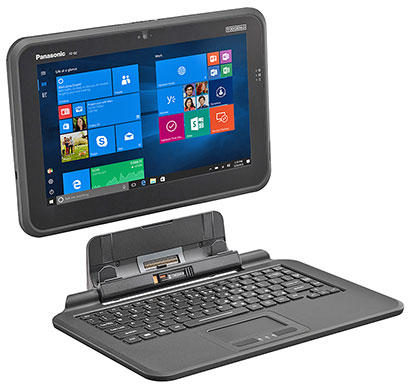On January 12, 2017, Panasonic introduced the Windows-based 12.5-inch Toughpad FZ-Q2 as both an upgrade and enhancement to its prior Toughpad FZ-Q1, as well as a re-positioning of the platform to a 2-in-1 convertible/hybrid. As a member of Panasonic's family of enterprise-grade rugged tablet computers, the upgraded Toughpad Q2 thus further bolsters its position as a "pro" tablet with a larger display, extra features, and now the fashionable 2-in-1 add-on functionality.

If you haven't noticed, as of the beginning of 2017 almost everyone who makes rugged tablets has added 2-in-1s. This trend was fueled in part by vendors seeking to give a maturing tablet market a new boost. And in part because the growing number of larger-screen, Windows-based tablets are seeing more time on office desks, and thus benefit from truly functional and well integrated, yet still detachable, keyboards.
This trend isn't new, but it does reflect the need of professional users for keyboards that work much better with tablets than run-of-the-mill generic 3rd party accessory keyboards.
But let's take a look at the tablet part of the Toughpad FZ-Q2. It's larger and heavier than Microsoft's slender, fragile 12.3-inch Surface Pro 4. But it's lighter and, despite being a Toughpad, not quite as rugged as Xplore's 12.5-inch XSLATE R12. That means the FZ-Q2 is a Toughpad with a shock-absorbing case and one of those magnesium alloy chassis Panasonic pioneered and is famous for, but this is a Toughbook that's as tough as it needs to be, and not as tough as it can possibly be.
Unlike the Q1 that came in two performance versions, the new Q2 comes in just one. It's now powered by a dual-core, quad-thread Intel Core m5-6Y57, has 8GB of onboard RAM, and 128GB or 256GB of SSD storage.
On the processor side, that's a step up from a 22nm lithography Intel 4th generation "Haswell" chip with Intel HD Graphics 4200 to a 5th generation 14nm "Broadwell" chip and Intel HD Graphics 515. While the old chip had a base frequency of 1.60GHz and maximum turbo speed of 2.30GHz, the new CPU, which has a much lower thermal design power (4.5 watts vs 11.5 watts) idles along at a base speed of just 1.1GHz, but can spool up all the way to 2.80GHz. Web sources suggest 30-50% higher performance for the new chip, depending on the test (see here).
As for the remaining specs, there's the large and reasonably bright 350 nit 12.5-inch display with full 1920 x 1080 pixel HD resolution, anti-glare treatment, preinstalled replaceable screen film, and 10-finger capacitive multi-touch. There's a capacitive stylus that we hope is of the same superior technology as the one Panasonic uses in the Toughpad FZ-M1. There's Bluetooth 4.2, speedy 802.11ac WiFi, optional 4G LTE multi-carrier mobile broadband with satellite GPS, USB 3.0 and a micro SDXC card slot. Optionally available are either a slot-based or contactless Smart Card reader. The 36 watt-hour Li-Ion battery is said to last up to 9 hours.
Onboard wired I/O is limited, as it is in most tablets: a USB 3.0 port, an audio jack and the power plug, and that's about it. The tablet has a 2-megapixel webcam in the front, and a 8-megapixel documentation camera in the rear. Since it's mandatory for many governmental and enterprise deployments, Panasonic also offers the FZ-Q2 with either standard or contactless Smart Card readers.
But what about ruggedness? While almost all Panasonic Toughbook and Toughpad products sport a distinctly rugged black and silver-metallic design language, the FZ-Q2 is all black and looks more like a standard contemporary consumer tablet. It's a fanless design thanks to its super-efficient processors and carries an IP5x rating, which means it's resistant to dirt and dust, but there's no rating for no protection against liquids (the FZ-Q2 does have port covers, though). The specs also do not include an operating temperature range, but do list an optional solid state drive heater. Thanks to the magnesium alloy chassis, ABS casing and elastomer edge guards Panasonic says it can withstand drops and provides "the ideal level of durability for light duty field work." Given Panasonic's track record in rugged notebooks and tablets we have no doubt it can, but do hope we'll get to see more detailed ruggedness specs in addition to just the "MIL-STD-810G design" designation.
Pricing has gone up. The standard version of the old FZ-Q1 started at just US$999, a Core-powered version at US$1,699. The new FZ-Q2, which of course now includes the keyboard, starts at US$2,299.
While the availability of a detachable keyboard designed specifically for this tablet will be welcomed by many customers, the upgrades in the Toughpad FZ-Q2 seem largely limited to a new processor and ancillary electronics. And economy-minded customers will miss the lower cost "standard" version.



